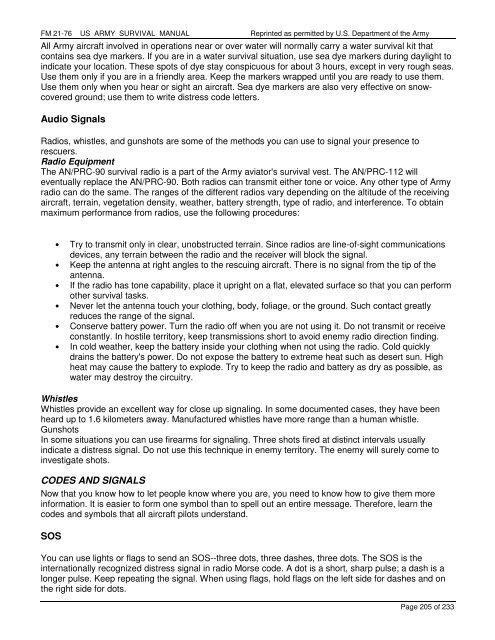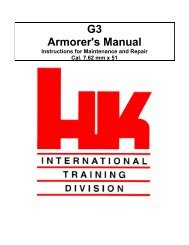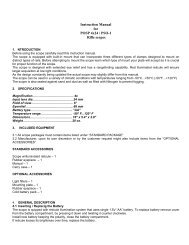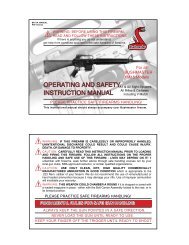FM 21-76 US ARMY SURVIVAL MANUAL - AR15.com
FM 21-76 US ARMY SURVIVAL MANUAL - AR15.com
FM 21-76 US ARMY SURVIVAL MANUAL - AR15.com
You also want an ePaper? Increase the reach of your titles
YUMPU automatically turns print PDFs into web optimized ePapers that Google loves.
<strong>FM</strong> <strong>21</strong>-<strong>76</strong> <strong>US</strong> <strong>ARMY</strong> <strong>SURVIVAL</strong> <strong>MANUAL</strong> Reprinted as permitted by U.S. Department of the Army<br />
All Army aircraft involved in operations near or over water will normally carry a water survival kit that<br />
contains sea dye markers. If you are in a water survival situation, use sea dye markers during daylight to<br />
indicate your location. These spots of dye stay conspicuous for about 3 hours, except in very rough seas.<br />
Use them only if you are in a friendly area. Keep the markers wrapped until you are ready to use them.<br />
Use them only when you hear or sight an aircraft. Sea dye markers are also very effective on snowcovered<br />
ground; use them to write distress code letters.<br />
Audio Signals<br />
Radios, whistles, and gunshots are some of the methods you can use to signal your presence to<br />
rescuers.<br />
Radio Equipment<br />
The AN/PRC-90 survival radio is a part of the Army aviator's survival vest. The AN/PRC-112 will<br />
eventually replace the AN/PRC-90. Both radios can transmit either tone or voice. Any other type of Army<br />
radio can do the same. The ranges of the different radios vary depending on the altitude of the receiving<br />
aircraft, terrain, vegetation density, weather, battery strength, type of radio, and interference. To obtain<br />
maximum performance from radios, use the following procedures:<br />
• Try to transmit only in clear, unobstructed terrain. Since radios are line-of-sight communications<br />
devices, any terrain between the radio and the receiver will block the signal.<br />
• Keep the antenna at right angles to the rescuing aircraft. There is no signal from the tip of the<br />
antenna.<br />
• If the radio has tone capability, place it upright on a flat, elevated surface so that you can perform<br />
other survival tasks.<br />
• Never let the antenna touch your clothing, body, foliage, or the ground. Such contact greatly<br />
reduces the range of the signal.<br />
• Conserve battery power. Turn the radio off when you are not using it. Do not transmit or receive<br />
constantly. In hostile territory, keep transmissions short to avoid enemy radio direction finding.<br />
• In cold weather, keep the battery inside your clothing when not using the radio. Cold quickly<br />
drains the battery's power. Do not expose the battery to extreme heat such as desert sun. High<br />
heat may cause the battery to explode. Try to keep the radio and battery as dry as possible, as<br />
water may destroy the circuitry.<br />
Whistles<br />
Whistles provide an excellent way for close up signaling. In some documented cases, they have been<br />
heard up to 1.6 kilometers away. Manufactured whistles have more range than a human whistle.<br />
Gunshots<br />
In some situations you can use firearms for signaling. Three shots fired at distinct intervals usually<br />
indicate a distress signal. Do not use this technique in enemy territory. The enemy will surely come to<br />
investigate shots.<br />
CODES AND SIGNALS<br />
Now that you know how to let people know where you are, you need to know how to give them more<br />
information. It is easier to form one symbol than to spell out an entire message. Therefore, learn the<br />
codes and symbols that all aircraft pilots understand.<br />
SOS<br />
You can use lights or flags to send an SOS--three dots, three dashes, three dots. The SOS is the<br />
internationally recognized distress signal in radio Morse code. A dot is a short, sharp pulse; a dash is a<br />
longer pulse. Keep repeating the signal. When using flags, hold flags on the left side for dashes and on<br />
the right side for dots.<br />
Page 205 of 233








